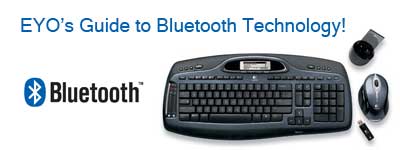EYO Guides: EYO's Guide to Bluetooth Technology
EYO Feature Article: EYO’s Guide to Bluetooth
(The copyrights© of all EYO Feature Articles are the property of Eyo Technologies Pty Ltd. Reproducing without permission is prohibited.)

EYO’s Guide to Bluetooth
Bluetooth is one of those technologies which has slipped into popular culture with an undeniable “cool” factor. Most people are exposed to Bluetooth in some way, but not everyone knows what it actually is.
Origins of Bluetooth
Bluetooth was first developed in 1994 by a couple of Ericsson developers in Sweden. Named after Harald Bluetooth, a Viking king of Denmark (King Harald I), Bluetooth was designed to facilitate wireless and directionless serial communication between devices where large amounts of bandwidth were not required. It was also designed to be short-range and low-power, which are two of the main differences between Bluetooth and Wi-Fi – both are radio standards and operate on the same frequency, but Wi-Fi uses more expensive, power-consuming equipment and therefore offers a stronger signal over a wider area with greater data throughput, making it ideal for its primary use in Ethernet networking. Bluetooth is primarily used for short-range communication which was previously handled by wired serial connections and later by infra-red. Bluetooth offers many advantages over both serial and IR, most notably greater bandwidth, security and the ability to connect multiple Bluetooth devices in an ad-hoc network environment.
Frequencies, Speeds, and Range
Bluetooth operates in the license-free 2.45 GHz ISM radio frequency. The band is then split up into 79 channels of 1Mhz each, and the Bluetooth signal skips between the channels 1600 times a second – this is to avoid interference and data loss by other devices operating on this same frequency (like Wi-Fi devices and even microwave ovens). Devices implemented with versions 1.1 or 1.2 of the Bluetooth protocol offer throughput of 723.1 kbps (around 90 kBps), whereas version 2.0 devices or later can reach speeds of 2.1 Mbps (around 260 kBps). Version 2.0 devices have a greater power draw, but this is offset by faster data transfers. A single master Bluetooth device can connect to up to seven other active devices in a closed, ad-hoc network called a piconet. Bluetooth’s effective range varies, depending on the type of device and the environment. A class 1 Bluetooth device has an effective range of 100m, whereas a class 2 device is limited to 10m. However, these are theoretical maxima, and the actual range can be reduced by interfering factors like walls, doors and other devices operating on the same radio frequency.
Uses and Implementations
Bluetooth has many popular implementations. Most people are familiar with Bluetooth on their mobile phones paired to a hand-free headset. Most PDAs come with Bluetooth to facilitate data synchronisation with a host computer. Most consumer notebooks come with an inbuilt Bluetooth adaptor to allow simple and effective communication with Bluetooth-enabled gadgets, and many printers also are capable of Bluetooth communications, allowing notebooks and handheld devices to print directly without the need for any cabling. Very few desktop computers come with Bluetooth functionality, requiring a USB Bluetooth dongle. Desktops generally use Bluetooth to transfer data with PDAs and mobile phones, and in some circumstances with other desktops in small, low-bandwidth networks.
Another very popular use for Bluetooth is for pre-paired input devices like keyboard, mice and tablets, and even gaming controllers like those used on the Nintendo Wii and Sony Playstation 3. Unlike most Bluetooth communication, Bluetooth keyboard/mouse combos use an adaptor which is operating system-independent and does not require any software or driver support. This means that these devices work with the host system regardless of whether the operating system is loaded or not (so you don’t have to plug in another keyboard to get into the BIOS). However these are the exceptions – the vast majority of computer-based Bluetooth devices rely on OS support.
The Future of Bluetooth
So where is Bluetooth going? As with most popular consumer technologies, Bluetooth is only going to get bigger and faster. The ad-hoc networking capabilities of the piconets will be expanded, allowing more seamless communication between devices, and higher bandwidth capacity means that Bluetooth devices will be able to send and receive much more high-quality data. You’ll be able to watch the latest news on your mobile from a Bluetooth advertising station, or control a dozen home devices from your PDA.
Sound good? Of course it does. But when a technology is so widespread and popular but so ill-understood by those using it, there is always an underlying concern whether people’s best interests are being protected. We’ve all heard of stories of celebrities’ phones being hacked and all their personal information pulled off and published for all the world to see. In an increasingly interconnected world, anonymity and protection of personal data become ever more important commodities.
EYO feature article write ups: Tell us a topic your interested in and we'll write about it!
EYO Technologies is asking you our valued customers to submit a technology or product related topic you would like us to write about and publish in our website. If you'd like to see a particular topic feature on any trends, technological advancement in computers or just want to learn more about a product then do let us know! Our friendly staff will look into your suggestion and if we think it would be useful we will write about it to be published on our homepage.
Simply email your suggested topic to:
Check out the past articles we have explored for our customers:


 Kingston Tool
Kingston Tool


